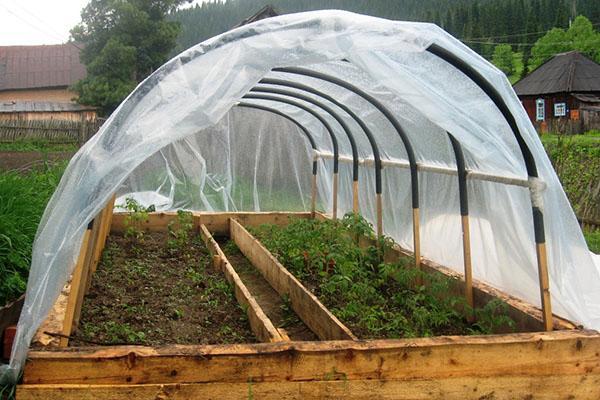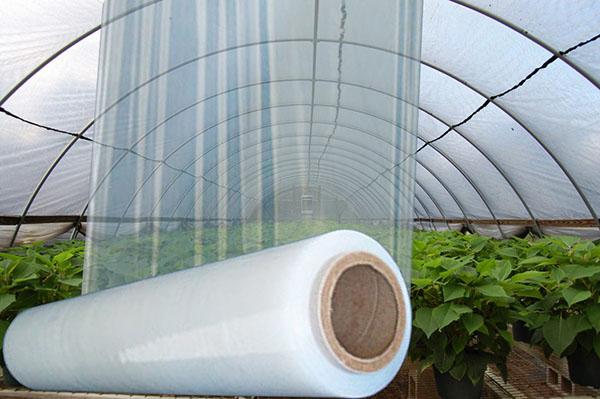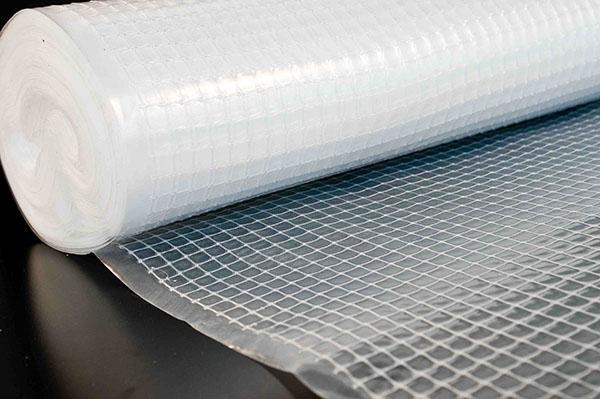How to choose greenhouse film to grow a good crop
 Early vegetables, aromatic greens and beautiful flowers are preferably grown in greenhouses. It is important for beginners and experienced farmers to know how to choose a film for greenhouses. Indeed, most often people use this particular covering material to protect plants from cold and sun.
Early vegetables, aromatic greens and beautiful flowers are preferably grown in greenhouses. It is important for beginners and experienced farmers to know how to choose a film for greenhouses. Indeed, most often people use this particular covering material to protect plants from cold and sun.
The main types of film shelters
There are several main varieties of greenhouse film.
Available polyethylene option

Material advantages:
- cheapness;
- does not change the biochemical properties of the soil;
- easy to attach;
- has a low weight;
- conducts up to 90% of sunlight.
Disadvantages:
- even a high-density product will rarely last more than one season;
- attracts dust and dirt, is difficult to clean;
- easily destroyed by careless use, from exposure to cold air, precipitation, wind;
- does not retain heat well at night, the soil and air in the greenhouse are cooled in a short time;
- even small damage spreads quickly;
- Condensation often forms on the surface, which damages the plants.
On sale you can find transparent or black products. There are also other colors. For example, green or orange sheeting for greenhouses.
The darker the material, the less light it lets through. In this case, a certain part of the solar radiation is reflected from the colored film, without falling on the plants.
Reinforced film
 The reinforced product consists of a polyethylene film and additional sheathing. The mesh frame is made from specially treated fiberglass, polypropylene or monofilament. Thin threads 0.29-0.32 mm wide form cells about 1-1.2 cm in size.
The reinforced product consists of a polyethylene film and additional sheathing. The mesh frame is made from specially treated fiberglass, polypropylene or monofilament. Thin threads 0.29-0.32 mm wide form cells about 1-1.2 cm in size.
Benefits:
- the main load in the product falls on the frame itself, so the material resists snow, rain well, and can withstand even a slight hail;
- sheltered seedlings are kept at outdoor temperatures down to -5 ° C;
- environmental friendliness;
- the average period of use is 3 years, some varieties can be operated up to 5-7 years;
- damage can be repaired, for example, holes can be sealed with tape;
- high tightness;
- easy to store and transport.
Disadvantages:
- generally less transparent than conventional polyethylene (light transmittance about 80%);
- high price;
- during operation, it becomes cloudy, attracts dust, because of this, it begins to pass light worse.
There are special holes in the high-quality reinforced film. Fresh air enters the room through them. Also, a breathable greenhouse film prevents condensation from accumulating on the surface of the material. The properties of the product depend on what the frame is made of. The response of different fibers to weather conditions is different.
Polyvinyl chloride film shelter
 In appearance, it resembles the pale yellow material from which medical dropper tubes are made. Through polyvinyl chloride, plants receive 90% of the sunlight and only about 5% of the ultraviolet radiation. By this property it resembles glass.
In appearance, it resembles the pale yellow material from which medical dropper tubes are made. Through polyvinyl chloride, plants receive 90% of the sunlight and only about 5% of the ultraviolet radiation. By this property it resembles glass.
Advantages of PVC:
- retains heat for a long time at night, suitable for delicate plants that do not like temperature changes;
- high elasticity and strength;
- does not rustle;
- easy to clean from dirt;
- will last at least 2 seasons.
Disadvantages of the material:
- 2-3 times more expensive than ordinary polyethylene;
- low frost resistance;
- strongly attracts dust and becomes electrified;
- sags, it is necessary to tighten from time to time.
With proper operation and favorable weather conditions, the PVC film shelter will last 5-7 years. The fragile material does not tolerate temperatures from -15 ° C and below, so in winter the greenhouse must be heated from it.
Additional characteristics of film shelters
Films are often produced with various additives. Special components give the covering material additional useful properties and improve its quality. What the designations indicated on the product say.
Stabilized and unstabilized film
 Light stabilizing additives reflect sunlight and protect plants from UV rays. Such a film does not look different from the usual one. It can be transparent or colored in bright colors. For example, orange or pink.
Light stabilizing additives reflect sunlight and protect plants from UV rays. Such a film does not look different from the usual one. It can be transparent or colored in bright colors. For example, orange or pink.  Diffusion film for greenhouses is more expensive. You can use it 2-3 times longer than usual.
Diffusion film for greenhouses is more expensive. You can use it 2-3 times longer than usual.
Plants under cover with light-stabilizing properties develop better, less likely to suffer from thermal burns.
Light converting material
 Special phosphor additives help to convert aggressive radiation. They convert ultraviolet light into infrared and red rays that are beneficial to plants. Thanks to this, the processes of photosynthesis occur faster, the yield of plants increases on average by 30-40%. The presence of light-converting additives can be determined by illuminating the film with an ultraviolet lamp. Under their influence, the light will turn red.
Special phosphor additives help to convert aggressive radiation. They convert ultraviolet light into infrared and red rays that are beneficial to plants. Thanks to this, the processes of photosynthesis occur faster, the yield of plants increases on average by 30-40%. The presence of light-converting additives can be determined by illuminating the film with an ultraviolet lamp. Under their influence, the light will turn red.
Heat-retaining variety
 Outwardly, this material is matte, dull white. Under the heat-retaining film, the temperature is a couple of degrees higher than under other shelters. This allows you to get products earlier, save on heating. The average service life is about 9 months.
Outwardly, this material is matte, dull white. Under the heat-retaining film, the temperature is a couple of degrees higher than under other shelters. This allows you to get products earlier, save on heating. The average service life is about 9 months.
Hydrophilic covering material
 On the surface of the film with hydrophilic properties, no drip condensation forms, which plants do not like. Special additives allow heat to pass well. The condensate does not form as drops, but as a continuous layer. It does not harm crops. The optimum thickness of the hydrophilic film is from 80 to 150 microns. Its service life is on average 3 years.
On the surface of the film with hydrophilic properties, no drip condensation forms, which plants do not like. Special additives allow heat to pass well. The condensate does not form as drops, but as a continuous layer. It does not harm crops. The optimum thickness of the hydrophilic film is from 80 to 150 microns. Its service life is on average 3 years.
Anti-static
 Thanks to anti-static additives, the film attracts less dust. The material stays transparent longer, it transmits light better. It has to be washed less often. Modern film covers with antistatic properties last from 2 years or more.
Thanks to anti-static additives, the film attracts less dust. The material stays transparent longer, it transmits light better. It has to be washed less often. Modern film covers with antistatic properties last from 2 years or more.
Copolymer film
 High quality material, dense, durable and flexible enough. Conducts up to 92% of light, has high hydrophilicity. Does not wear out for a long time, retains heat well. A distinctive feature of the copolymer film is its increased frost resistance. It is recommended to be used for growing crops in regions with an unstable and difficult climate. Manufacturers usually give a 3-year warranty on the frost-resistant properties of the copolymer film. Among the disadvantages of products - in extreme heat, plants can overheat under such a shelter.
High quality material, dense, durable and flexible enough. Conducts up to 92% of light, has high hydrophilicity. Does not wear out for a long time, retains heat well. A distinctive feature of the copolymer film is its increased frost resistance. It is recommended to be used for growing crops in regions with an unstable and difficult climate. Manufacturers usually give a 3-year warranty on the frost-resistant properties of the copolymer film. Among the disadvantages of products - in extreme heat, plants can overheat under such a shelter.
Specific types of film
Some types of products have a special structure:
- Bubble wrap resembles the fine honeycomb wrap used to package fragile goods. It retains heat well. Light transmits weakly, does not differ in high strength.

- Agrofibre is a special non-woven material with polymer additives. White varieties are used as a covering agent, and black varieties are used for soil mulching. Agrofibre does not need a strong frame. It has a low price, but it has poor thermal insulation. Service life up to 3 years.

- Infrared film is an innovative development. This is not a covering material, but a heating agent.It is powered by an electrical network, has a temperature controller and is mounted on a frame. Infrared film is used in conjunction with other winter-hardy covering materials to grow thermophilic plants in the cold season. The service life of the products is up to 30 years.

- Photodegradable film - material decomposes on its own after a certain period. This usually takes 20 to 60 days.

Apply photodegradable film for mulching soil, make frameless shelters for plants from it.
How to choose a film for greenhouses and not lose it
 Finding the right film can be tricky. What to look for when buying.
Finding the right film can be tricky. What to look for when buying.
The size
For a small tunnel-type greenhouse, a plastic film 3 m wide is sufficient. If you need to cover a stationary high greenhouse, it is convenient to use a wider option. For example, a 3-meter double sheet, the total width of which is 6 m. In such a film, the fold is quickly worn out, so it is appropriate to seal it with tape before use.
Price
Some gardeners prefer to change the cheap film every year, while others buy expensive types for several years. Usually a cheap material with a thickness of 100-150 microns is enough for one season. A reinforced product with a density of about 200 g / m² can be used for several seasons and not disassembled for the winter. Which film is best for a greenhouse depends on the specific situation. The financial capabilities, goals and experience of the gardener, as well as the types of plants that are planned to be cultivated, matter.
Durability and frost resistance
Any material loses its properties over time. Conventional plastic wrap rarely lasts more than one year. Reinforced and polyvinyl chloride have a longer service life. It is important to fix the film correctly. This will extend her life, reduce the risk of damage.
Under the same weather conditions, it will be warmer under a PVC film than in a greenhouse made of ordinary polyethylene material.
Scope of application and color scheme
 Blue greenhouse sheeting works well for seed germination. If you replace an eighth of the transparent coating with a material of this color, then the greenhouse freezes less. And cultures grow better in it.
Blue greenhouse sheeting works well for seed germination. If you replace an eighth of the transparent coating with a material of this color, then the greenhouse freezes less. And cultures grow better in it.
Transparencies are better for light transmission. Dyes are added to the color, which fade over time. Saturated colors can reduce yields if sunny days are not enough. Greenhouse red sheeting is believed to convert solar radiation and protect plants from ultraviolet radiation. Thanks to this, they develop and bear fruit better. Usually color does not play a significant role, but it can become part of the design decision.
Thickness and density
The quality of the product depends more not on its thickness, but on its density. For example, for a reinforced material, an indicator from 130 to 300 g / m² is sufficient.
How to choose a film for greenhouses taking into account various indicators, its labeling will tell. After all, outwardly, different types of material look the same, and their price can differ significantly. Unscrupulous sellers sometimes pass off one product for another. It is necessary to carefully study the certificates, marks on the product, so as not to be mistaken with the choice.
Covering products are marked with different symbols in accordance with GOST 10354-82.
For instance:
- stabilized covering material - ST;
- non-stabilized and stabilized film for greenhouses for household use - H;
- light-converting materials - SIK.
It is advisable to purchase products in specialized stores with a good reputation. A wise choice of greenhouse film increases the chances of getting a high yield at the lowest cost.